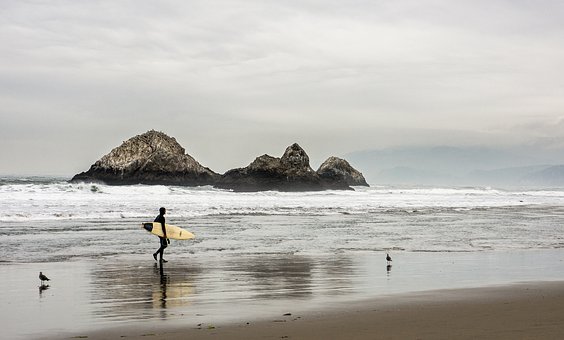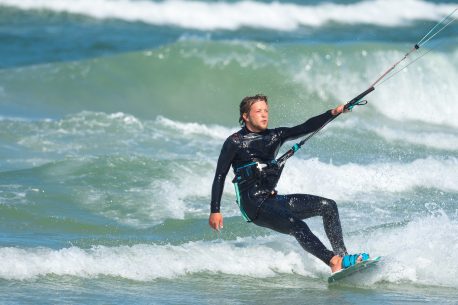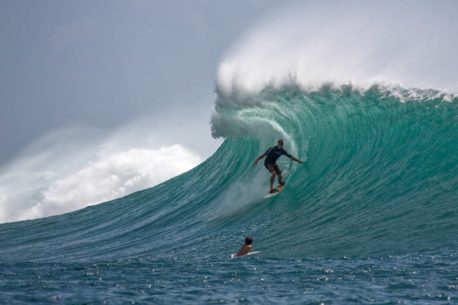

Surfing in Okinawa is awesome! Okinawa prefecture is made up of 161 islands, of which only 44 are inhabited. The most southern island lies about 100km(62mi) from Taiwan. Although once an independent state, the Ryukyu Islands are now the most popular resort beach destination in Japan, thanks to the temperate climate and coral reefs located off the beaches. Okinawa lies in the middle of Typhoon Alley, sandwiched between the Pacific Ocean on its east side and the East China Sea on its west one. The waves here break very superficially on reefs and / or basalt rocks, which is why 90% of the spots are safer at medium-high tide. The prevalence of the breaks are covered by 2-4ft of water during high tide. There are only two sandy beachbreaks. The main spots are crowded, but some breaks are always empty. Most of the outer reefs and islands are still unexplored-. The north side is less crowded and it is home to several spots: Ko-Chan , also known as Hudo Point, is a better summer right with E swells and S-SE winds. The take-off is steep, but the wave then becomes softer. Despite its remote location, Aha Port suffers from crowding as it is one of the busiest spots at low tide. The more adventurous can head to Ikei Island, stay in the Big Time Hotel and here they can expect the right conditions. The reefs overlooking the hotel enjoy large swells. If the swell increases, the west side of Ikei produces excellent rights but you will have to be careful to sea urchins and strong currents. Another island worth visiting, 1h by ferry from Bateh Harbor, is Kudaka , which has a very long left pointbreak, right next to a seawall and a small marine island. Normally here you will find many separate sections, but when these are combined with the larger NE swells, the wave becomes a real beauty! If you can, stop here all day: the “soba” house is one of the best places for a hot meal. Suicide Cliffs is the most constant summer spot, thanks to its proximity to Naha, but it is also the busiest. This place is very wild and the access to the water is made difficult by the very slippery rocks. This place has to be avoided if the swell is above 4ft and winds blow from Northeast.
Walk further south to Castles , a much less crowded spot that offers a left point with two long sections. The west side has a number of spots and a population density such that even the winter breaks of Aja or Bowls become crowded. Unfortunately the quality reefs, to work better, rely on the combination of poor windswells from the north and winds from the southeast, which are very rare. Bowls can give amazing a-frames. Without doubt, Sunabe Seawall is the main surfing spot as it is home to many reefbreaks such as the long lefts of Typhoon Break, the rights of Hotels, and the short peaks of 5-Rocks, etc. Further north, Turtles can produce giant lefts, (perhaps among the largest waves ridden in Okinawa) but it is known for the strong currents that have sometimes dragged surfers to the seawall. Kamikaze bodyboarders have to go towards Cape Zanpa to ride one of three Mainside breaks. Here you will find tubing rights but the external reef is definitely the most radical and consistent wave on the island. Also check out Meada which offers excellent conditions for fishing and diving. The spot closest to Nago City is Buma , with left and right pointbreaks, but it isn’t so constant.
Tariff per person, starting from:
| Departure | Kumoji-So Hostel | Apa Hotel & Resort |
|---|---|---|
| Double | Double | |
| From 1 January 2020 to 31 December 2020 | € 236 | € 689 |
Notes
Okinawa has two types of swells which, apart from the flat spring, produce waves all year round with a mix of windswells from south and north. Summer swells are produced by tropical weather changes and typhoons, usually accompanied by winds from south. July is usually the month with consistent swells on the south and east sides. Summer reaches its peak between August and October with many typhoons and occasional super typhoons, which release up to 13ft in all sides of the island. The west coast receives two / three typhoons while the east coast around the double. The west coast is calm in the summer but become better between November-March when the low pressures move towards Korea releasing 3-8ft short choppy windswells. Low pressures bring NW winds as the storm approaches and end in northeast and east, giving clean surf conditions on the west side. A classic winter season sees the west coast with 10-15 days of good surfing conditions and another 5-10 days of poor ones. The east coast is reasonably consistent during the winter but almost always affected by NE onshore winds. Tides can reach 7ft during the spring. For safety, surf for 2 hours before and after the high tide.
How to get there : No visa is required for less than 90 days. You can fly to Naha (AHA) from Hong Kong, or Taiwan. There are daily flights from Tokyo, Osaka, Nagoya and Fukuoka. Operating airlines: JAL; ANA; JAS; ANK; JTA. From Tokyo to Okinawa the ticket costs about $ 290 return. Board fees range from $ 60 to $ 165 for inter-island domestic flights. Naha-Miyako: $ 105.
Getting around : It is essential to rent a car which costs about $ 80 per day. Traffic is often heavy and the language in all signs is Japanese. Traffic in Road 58 gets higher during peak hours from Naha to Nago, so take the fast S8 road. If you don’t speak Japanese, use buses and taxis. The taxi ticket starts at $ 30 then $ 0.50 for every 407m of drive: traveling 20km(12mi) costs about $ 28. You drive on the left.
Accommodations and Food : There are three types of accommodations: 1) City Hotel in the Naha area, Sunabe and Chatan-cho on the west side for $ 50-60 per night. 2) Beach Resort in the central part and the most northern parts such as Big Time in Ikel. 3) Resort on the islands. The facilities are very good but the prices are between $ 60 and $ 300 per night. You will pay around $ 15-20 for a meal.
Climate: Okinawa receives only the Japanese oceanic subtropical climate with average annual temperatures around 22.5 ° C, which allow pineapples and sugar cane to grow properly. Being an island, Okinawa is heavily influenced by seasonal winds: it receives winds from the south in the summer and winds from the north during the winter. In the summer months between July and September many days the temperatures reach above 30 ° but be careful because the storms could arrive at any moment (Okinawa receives about 7-8 storms a year). In winter and temperatures never drop below 10 ° C, but the cold wind that comes from Korea can be a problem. The water temperature varies between 20-30 ° C, so you only need a spring wetsuit for the coldest days, and a swimsuit for the rest of the year.
Nature and Culture : The longevity rank of Okinawans is the first in the world: a healthy diet, mild climate and a peaceful society. Here you will find beautiful white sand beaches, 40 golf courses, excellent conditions for diving and Togyu Bull fighting. There are also sun festivals, Ocean & Jogger and Dragon boat competitions. It is the capital of karate.
Dangers and annoyances : The coral reef is alive, sharp and superficial so reef cuts could be frequent. Many locals wear boots and a helmet. There were shark attacks in Miyako: a surfer died in 2000. There aren’t so much crimes. The main problem is traffic and crowds.
Practical advice : Surfing equipment can be purchased at the Source Surf Shop or Ryukyu Glass Factory but the prices are high. Prices hover around: longboard ($ 800), shortboard ($ 500), bodyboard ($ 230), spring wetsuit ($ 200). Renting a board costs $ 25 per day. Bring your best shortboard. “Mensor” means welcome, many locals speak English.
Exchange rate 1 EUR = 1.08 USD
Exchange rate variations (more than 3%) will lead to an adjustment of costs. They will be communicated within 20 days of departure.
The tariff does not include

Kitesurfing is a recently invented sport, born as a variant of surfing, which consists in being towed with a suitable board at your feet, by a kite, which uses the wind as a propeller and which is maneuvered through a “control bar” in turn connected to the kite by thin cables (four or five), between […]

The highest waves in the world, the most reckless surfers, but above all the most beautiful beaches: this is where board lovers go to face the fury of the sea and come out victorious. However, surfing is also an excellent excuse for a beach holiday. Board under the arm and off to adventure. The waves […]